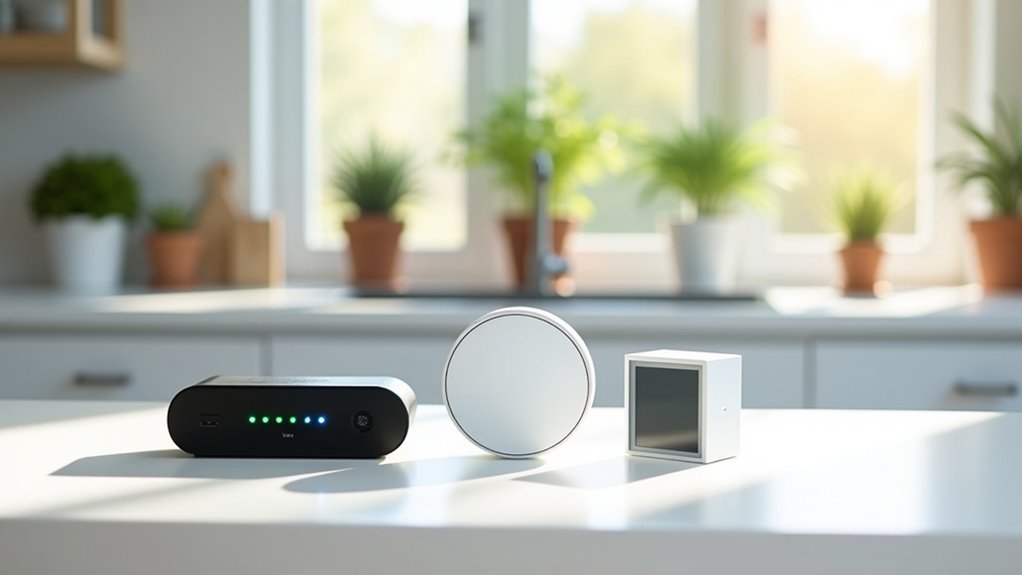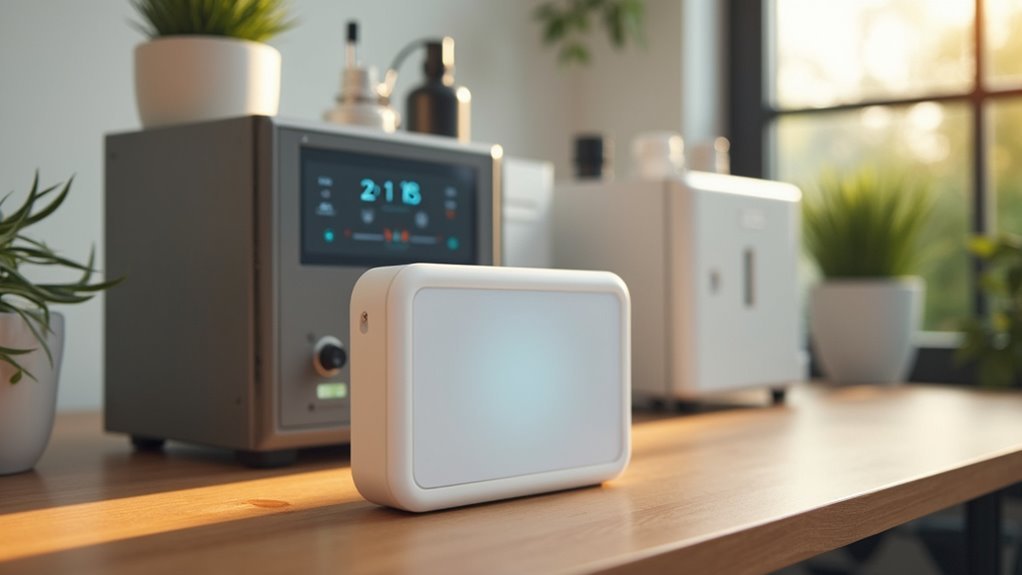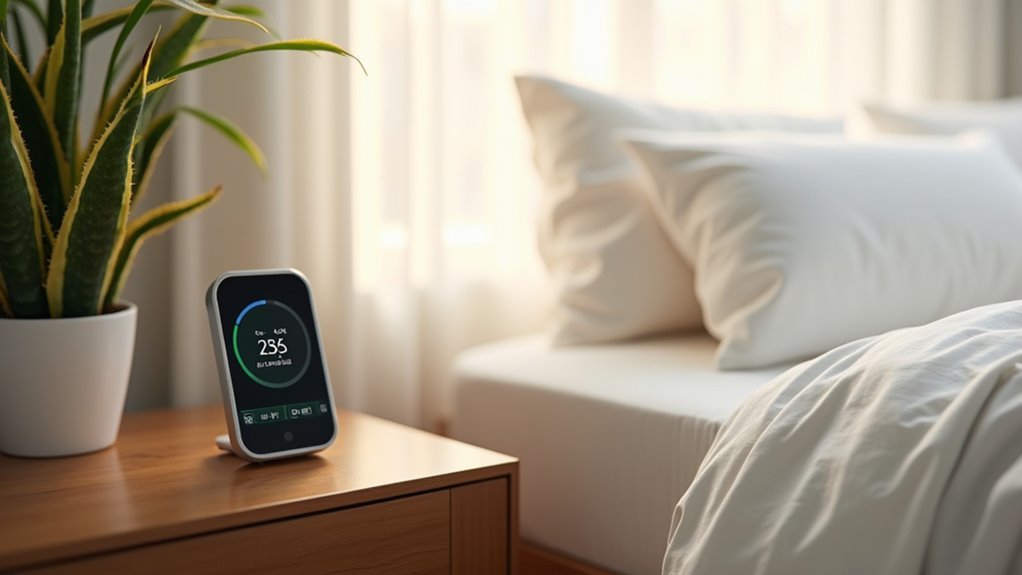You don’t need to spend hundreds of dollars to protect your family’s health through air quality monitoring. Affordable indoor air monitors, priced between $70-$200, can detect the same critical pollutants as their premium counterparts—including CO2, PM2.5, and VOCs—with surprisingly accurate results. What’s more interesting is how these budget-friendly devices often outperform expensive models in specific scenarios, making the decision about which monitor to choose far more complex than price alone suggests.
Understanding Indoor Air Quality Monitoring Basics

While outdoor air quality often captures public attention, the air inside your home can actually contain higher concentrations of harmful pollutants that directly impact your health.
Indoor air quality monitors serve as essential tools for detecting these hidden threats by measuring levels of common pollutants like carbon dioxide, volatile organic compounds, and particulate matter.
Indoor air quality monitors detect hidden pollutants like carbon dioxide, volatile organic compounds, and particulate matter in your home.
These devices use advanced sensors to deliver real-time data about your living space’s air quality, alerting you when pollutant levels exceed safe thresholds.
What’s particularly encouraging is that affordable monitors can deliver performance comparable to expensive models, making effective air quality monitoring accessible to most households.
Understanding these basics helps you recognize why continuous monitoring of indoor air pollutants isn’t just beneficial—it’s necessary for protecting your family’s health.
Key Pollutants That Affordable Monitors Can Detect
When you’re shopping for an affordable indoor air monitor, you’ll want to focus on devices that can detect the most common and harmful pollutants in your home.
Carbon dioxide detection is essential since levels above 1,000 ppm indicate poor ventilation that can impair your cognitive function and overall well-being.
Particulate matter monitoring is equally important, as these tiny PM2.5 particles can penetrate deep into your lungs and bloodstream, causing serious respiratory and cardiovascular health issues.
Carbon Dioxide Detection
Carbon dioxide stands as one of the most important pollutants that affordable indoor air monitors can reliably detect and measure. When CO2 levels climb above 1,000 ppm in your home, you’ll experience discomfort, fatigue, and reduced cognitive function.
These budget-friendly devices use accurate NDIR sensor technology with deviations typically within 15% of reference measurements.
Your affordable indoor air monitors provide essential real-time alerts when carbon dioxide concentrations spike, indicating poor ventilation in tightly sealed spaces. You’ll receive immediate notifications to open windows or adjust your HVAC system.
Particulate Matter Monitoring
Particulate matter represents another critical pollutant that your affordable indoor air monitors can accurately track and measure.
These tiny PM2.5 particles penetrate deep into your lungs, linking to serious health issues like heart disease and asthma. Budget-friendly monitors deliver accuracy within 50% of reference measurements, making them suitable for effective indoor air quality management.
Your affordable monitors help you identify common sources of indoor pollutants:
- Cooking activities – Sizzling pans releasing microscopic particles into your kitchen air
- Burning candles – Flickering flames creating invisible clouds of particulate matter
- Dust accumulation – Settled particles becoming airborne during daily activities
- Outdoor infiltration – External pollution seeping through windows and doors
Regular PM2.5 monitoring empowers you to improve ventilation and reduce exposure to harmful indoor pollutants effectively.
Essential Features to Look for in Budget Air Quality Monitors

Although budget constraints might tempt you to choose the cheapest option available, selecting an indoor air monitor requires careful consideration of specific features that’ll actually protect your health.
Your affordable indoor air monitors should detect key pollutants including CO2, PM2.5, and VOCs for thorough monitoring.
Prioritize models offering real-time data through user-friendly interfaces, whether via clear visual displays or mobile apps that simplify air quality metrics interpretation.
Essential alert systems notify you when high pollutant levels exceed safe thresholds, enabling immediate corrective action.
Don’t overlook practical considerations like battery life and wireless portability, which allow flexible placement throughout your home.
Many budget-friendly options deliver performance comparable to expensive alternatives while maintaining these vital monitoring capabilities.
Top Affordable Indoor Air Quality Monitor Models
You’ll find several standout models that deliver excellent air quality monitoring without breaking your budget.
The Aranet4 HOME and Airthings Wave Radon Detector consistently rank among the top choices, offering extensive feature sets that rival more expensive alternatives.
We’ve tested these monitors against pricier competitors to show you exactly what performance you can expect for your investment.
Budget-Friendly Monitor Options
Several excellent indoor air quality monitors deliver professional-grade performance without the premium price tag.
These affordable indoor air quality monitors typically cost between $150-$200, making them accessible for most households seeking extensive monitoring solutions.
Budget-friendly models like the Airthings Wave Plus offer remarkable value by tracking multiple environmental factors simultaneously.
You’ll find devices under $100 that effectively measure carbon dioxide and particulate matter levels, performing comparably to expensive alternatives.
Key features that make these monitors exceptional include:
- Multi-parameter monitoring – VOCs, humidity, temperature, and radon detection in one device
- NDIR technology integration – Ensuring accurate CO2 measurements like the Aranet4
- Mobile app connectivity – Real-time monitoring and instant air quality alerts
- User-friendly designs – Simple setup and intuitive interfaces for effortless operation
These extensive air quality insights help you maintain healthier indoor environments affordably.
Key Features Comparison
When comparing top affordable indoor air quality monitors, the Airthings Wave Plus stands out by delivering thorough monitoring capabilities that rival expensive alternatives. You’ll find these budget-friendly models offer extensive pollutant detection without breaking your bank.
| Monitor | Key Measurements | Price Range |
|---|---|---|
| Airthings Wave Plus | Radon, CO2, VOCs, PM2.5, humidity | $150-$200 |
| Aranet4 HOME | Carbon dioxide (CO2), temperature, humidity | $150-$200 |
| Airthings Wave Radon | Radon, temperature, humidity | $150-$200 |
These affordable indoor air quality monitors feature mobile app compatibility for real-time tracking and alerts. You’ll appreciate their user-friendly interfaces that make monitoring volatile organic compounds (VOCs) and particulate matter (PM2.5) effortless. Performance evaluations confirm these low-cost models deliver accurate readings comparable to premium alternatives, ensuring effective indoor air quality management.
Performance Testing Results
Rigorous testing reveals how these affordable monitors actually perform in real-world conditions.
Performance testing demonstrates that most indoor air monitors accurately measure carbon dioxide levels within 15% of professional-grade equipment, making them reliable tools for air quality management.
However, you’ll need to interpret particulate matter readings carefully, as many units under-report these measurements by up to 50%.
Key testing findings include:
- The Awair 2 Edition achieved highest overall accuracy across multiple environmental parameters
- Seasonal conditions barely affected performance, ensuring consistent year-round reliability
- Strong correlation with reference data validates their effectiveness for monitoring
- Successful detection of pollution source events proves their practical value
You can confidently use these affordable devices for basic indoor air quality monitoring, understanding their limitations while leveraging their strengths.
Cost Comparison: Budget Vs Premium Air Quality Monitors
Although premium air quality monitors can cost several hundred dollars, affordable indoor air monitors in the $70 to $100 range deliver surprisingly comparable performance for most home monitoring needs.
You’ll find that budget monitors consistently detect key pollutants like carbon dioxide and particulate matter with accuracy that rivals expensive alternatives. These devices represent a cost-effective option for basic air quality monitoring without sacrificing essential detection capabilities.
When you’re comparing costs, remember that premium models often include advanced features you mightn’t need for everyday home management.
Testing reveals that budget monitors provide sufficient data for taking immediate action on air quality issues. You can achieve reliable monitoring and make informed decisions about your indoor environment without investing in expensive equipment that exceeds your practical requirements.
Performance Accuracy of Low-Cost Air Quality Sensors

Independent testing reveals that affordable air quality monitors deliver impressive accuracy despite their lower price points.
You’ll find that low-cost air quality monitors measuring between $70-$100 can match higher-priced models’ performance accuracy in detecting pollutants and delivering real-time data for effective indoor air quality management.
These budget-friendly devices accurately measure carbon dioxide levels within 15% of reference standards, making them reliable for monitoring your indoor environment.
Here’s what you can expect:
- Consistent seasonal performance – Your monitor functions reliably year-round regardless of environmental conditions
- Strong correlation with reference data – Devices effectively detect pollution source events in real-time
- Multi-parameter monitoring – The Awair 2 Edition excels at measuring various environmental parameters including temperature and humidity
- Reliable particulate detection – Despite under-reporting by up to 50%, monitors still provide valuable trending data
Real-World Benefits of Monitoring Indoor Air Quality
Beyond delivering reliable measurements, these affordable monitors transform how you manage your home’s health environment.
You’ll gain real-time insights into carbon dioxide (CO2) and volatile organic compounds (VOCs) levels, enabling immediate action when pollutants spike. Since indoor air quality often exceeds outdoor pollution levels, monitoring becomes essential for your family’s wellbeing.
Indoor air pollution frequently surpasses outdoor levels, making real-time monitoring crucial for protecting your family’s health and immediate response capabilities.
These affordable indoor air monitors help you identify patterns and seasonal fluctuations, prompting timely ventilation or dehumidification.
When CO2 climbs above 1,000 ppm, you’ll know to increase airflow before experiencing cognitive decline or fatigue. For family members with asthma or allergies, tracking air quality trends prevents symptom triggers.
The result? Improved health outcomes through proactive environmental management, creating a safer, more comfortable living space.
Common Problems With Cheap Air Quality Monitors
While affordable air quality monitors offer valuable insights into your home’s environment, several significant drawbacks can compromise their effectiveness.
These reliability issues can undermine your ability to make informed decisions about indoor air quality.
The most common problems with budget monitors include:
- VOC sensors failing within 6-12 months, leaving you with incomplete air quality data when you need it most
- Particulate measurements under-reporting by up to 50%, giving you false confidence about potentially harmful pollution levels
- Inconsistent performance across different units, making it difficult to trust readings from affordable models
- Insufficient precision compared to professional equipment, limiting your ability to detect subtle but important air quality changes
These limitations can leave you wondering whether your monitor’s readings accurately reflect your home’s actual air quality conditions.
Placement Strategies for Maximum Monitor Effectiveness
Strategic placement transforms even affordable air quality monitors into effective tools for protecting your family’s health. Your placement strategies directly impact how well these monitors detect pollutants and provide accurate readings for indoor air quality assessment.
Position monitors in high-traffic areas like living rooms and kitchens where cooking and daily activities generate the most pollutants. Children’s bedrooms require special attention since kids are more vulnerable to poor air quality. Install monitors at breathing height—3 to 5 feet off the ground—for the most accurate readings.
| Best Locations | Avoid These Areas |
|---|---|
| Living rooms/kitchens | Near windows/doors |
| Children’s bedrooms | Close to vents |
| Basements (radon) | Direct sunlight |
| Home offices (CO2/VOCs) | High/low extremes |
Consider multiple monitors throughout your home for thorough coverage.
Mobile Apps and Data Management for Budget Monitors
Affordable air quality monitors gain significant value through their mobile app capabilities, which transform raw sensor data into actionable insights you can access anywhere.
These budget-friendly devices deliver real-time data on CO2 levels, temperature, and humidity straight to your smartphone, making indoor air quality monitoring effortless and convenient.
Your mobile app becomes a powerful dashboard featuring:
- Color-coded visual alerts that instantly show whether your air quality is good, moderate, or poor
- Historical data storage that reveals patterns in your home’s air quality over weeks and months
- Smart recommendations for improving ventilation, adjusting humidity, or taking other corrective actions
- Integration with outdoor data through apps like AirNow for thorough environmental awareness
These features help you make informed decisions about your indoor environment without breaking your budget.
When Budget Monitors Are Sufficient Vs When to Upgrade
How do you know whether a budget air monitor will meet your needs or if you should invest in a premium model?
Budget monitors work well for basic home use when you want general air quality awareness and real-time alerts for CO2 and PM2.5 levels. They’re sufficient if you’re monitoring standard indoor environments without specific health concerns.
However, you should consider premium options when you need precise VOCs measurements or have vulnerable family members like children or those with respiratory issues.
Budget monitors can underreport pollutant levels by up to 50%, which matters when reliable data is essential. If you require thorough data logging, mobile app integration, or long-term monitoring accuracy, upgrading guarantees you’ll get dependable air quality readings for important health decisions.
Maintenance and Lifespan of Affordable Air Quality Devices
You’ll need to understand what to expect from your budget air quality monitor’s sensors and how long they’ll actually last before requiring replacement.
Most affordable devices use sensors that degrade considerably within 1-3 years, with VOC sensors often failing within just 6-12 months of regular use.
Regular calibration and battery replacement aren’t just recommended maintenance tasks—they’re essential for keeping your readings accurate throughout your device’s shortened lifespan.
Sensor Lifespan Expectations
When you’re shopping for budget-friendly air quality monitors, understanding sensor lifespan becomes critical since these devices typically deliver reliable performance for only 6 to 12 months before accuracy starts declining.
VOC sensors particularly struggle with longevity in affordable models, often experiencing reliability issues that compromise long-term monitoring capabilities.
You’ll need to plan for these realistic expectations:
- VOC sensors degrading after 6-12 months – causing false readings in your living spaces
- Calibration drift occurring gradually – making your data less trustworthy over time
- Performance gaps widening – between your affordable monitor and professional-grade equipment
- Replacement costs accumulating – potentially exceeding initial affordability benefits
While budget monitors provide immediate air quality data, their sensor lifespan limitations mean you’re trading long-term accuracy for upfront savings.
Basic Maintenance Requirements
Although affordable air quality monitors won’t last as long as professional equipment, they do require surprisingly little maintenance to keep running effectively.
Your affordable indoor air monitors need regular sensor cleaning to maintain accuracy and extend their operational life. Simply wipe sensors gently with a soft, dry cloth to remove dust and debris that can interfere with readings.
You’ll occasionally need calibration, especially after exposure to high pollutant levels or environmental changes. Most models provide straightforward calibration procedures in their user manuals.
Don’t forget about software updates for smart monitors – these updates often improve accuracy and add new features. Battery-operated units like the Aranet4 HOME require minimal power management, lasting months between charges.
Smart Home Integration Options for Budget Air Monitors
Integrating your budget air monitor with smart home systems transforms basic air quality tracking into a thorough environmental management solution.
Smart air quality monitors like the Airthings Wave Plus and Awair Element offer seamless smart home integration, connecting with automation systems for enhanced air quality management. These devices utilize mobile apps for real-time monitoring, sending instant alerts when air quality changes occur.
Key integration capabilities include:
- Automatic HVAC adjustments – Your monitor communicates with heating and cooling systems to maintain ideal air quality.
- Voice assistant compatibility – Query air quality data through Amazon Alexa or Google Assistant commands.
- Smart purifier control – Devices like Foobot automatically activate air purifiers when pollutants are detected.
- Data trend analysis – Long-term air quality tracking helps improve your indoor environment over time.
Making the Most of Your Affordable Air Quality Monitor Investment
Beyond connecting your air quality monitor to smart home systems, maximizing your investment requires strategic placement and consistent monitoring habits.
Position your affordable air quality monitor in high-traffic areas where you spend most time, avoiding direct sunlight or heat sources that could skew readings.
Place your air quality monitor where you spend the most time, away from sunlight and heat sources for accurate readings.
Check CO2 levels regularly and take immediate action when they exceed 1,000 ppm by increasing ventilation.
Use your device’s historical data features to identify patterns and potential health risks in your indoor air quality.
Set up alerts through mobile apps to stay informed about sudden changes.
Most importantly, don’t just monitor air quality—act on the data by adjusting ventilation, using air purifiers, or eliminating pollution sources when readings indicate poor conditions.
Frequently Asked Questions
Are Cheap Air Quality Monitors Good?
You’ll find cheap air quality monitors surprisingly effective. They accurately detect PM2.5, VOCs, and CO2 levels comparable to expensive models. You can validate their responsiveness easily and get valuable data for managing your indoor air quality.
Do I Need an Indoor Air Quality Monitor?
You should consider an indoor air quality monitor since you spend 90% of your time indoors where air can be more polluted than outside, helping you identify harmful contaminants and protect your health.
Which Indoor Air Quality Monitor Is Best?
You’ll find the Airthings View Plus offers the most thorough monitoring with seven factors including CO2 and PM2.5. However, if you’re budget-conscious, affordable models around $70-100 perform comparably well.
Is Indoor Air Quality Testing Worth It?
You’ll find indoor air quality testing absolutely worth it since you’re exposed to pollutants 90% of your time indoors. Testing helps you identify harmful substances and take action to protect your health.





Leave a Reply